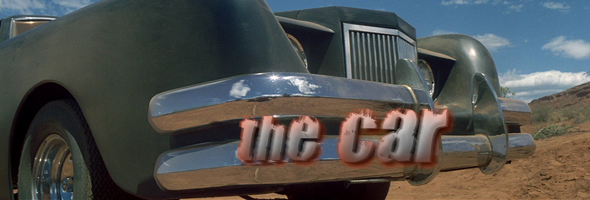
Color, 1977, 96m.
Directed by Elliot Silverstein
Starring James Brolin, Kathleen Lloyd, John Marley, R.G. Armstrong, John Rubinstein, Elizabeth Thompson, Roy Jenson, Kim Richards, Kyle Richards
Arrow (Blu-Ray) (UK RB HD), Universal, Anchor Bay (DVD) (US R1 NTSC) / WS (2.35:1) (16:9)
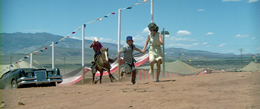 Perhaps the first feature film to cash in on two Steven Spielberg films
Perhaps the first feature film to cash in on two Steven Spielberg films 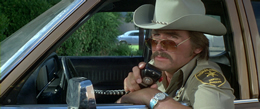 at the same time, The Car was pushed into production by Universal as "Jaws on land," attempting to come up with a movie to tide audiences over in 1977 until the studio could turn out a bona fide sequel to their big shark hit one year later. For good measure, you get a big dose of Spielberg's Duel here as well courtesy of a supernatural vehicle straight from the bowels of hell, determined to mow down anyone in its path.
at the same time, The Car was pushed into production by Universal as "Jaws on land," attempting to come up with a movie to tide audiences over in 1977 until the studio could turn out a bona fide sequel to their big shark hit one year later. For good measure, you get a big dose of Spielberg's Duel here as well courtesy of a supernatural vehicle straight from the bowels of hell, determined to mow down anyone in its path. 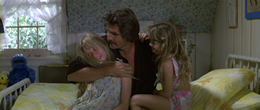 also resulted in some other treasures that are still scarce today like FM and I Saw What You Did). Amusingly, their packaging referred to the film as "existentialist" and likened it to Ingmar Bergman, which is stretching things just a tad.
also resulted in some other treasures that are still scarce today like FM and I Saw What You Did). Amusingly, their packaging referred to the film as "existentialist" and likened it to Ingmar Bergman, which is stretching things just a tad. 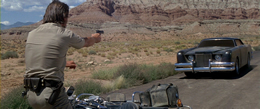 one of the film's greatest assets, combining crisp desert vistas with gleaming, menacing shots of the car careening through dusty highways; it's an unusual way to design a horror film, but it certainly sticks in your memory.
one of the film's greatest assets, combining crisp desert vistas with gleaming, menacing shots of the car careening through dusty highways; it's an unusual way to design a horror film, but it certainly sticks in your memory.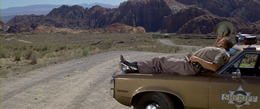 rechanneled 5.1 mix as well, but you won't miss it.) As for extras, you get a new audio commentary with director Elliot Silverstein, who was presumably hired due to his previous western experience on Cat Ballou and A Man Called Horse. Moderator Calum Waddell, who's done some excellent commentary work for Arrow in the past, does his damnedest to keep things afloat here, but it's obvious Silverstein doesn't remember much about making the film beyond the difficulties of the desert setting. If you've heard other chat tracks with older directors decades removed from the film they're watching, you probably have a good idea of what to expect. Waddell's observations are still good and make this worth a listen, even when Silverstein is weirdly denying having directed the MGM drive-in oddity Nightmare Honeymoon. On the video end you get a 28-minute "Making a Mechanical Monster," with special effects artist William Aldridge talking about the "strictly business" relationship he had with Silverstein and the various visual tricks used to pull off the film's car attack scenes, as well as his other career highlights like Die Hard. Actor John Rubinstein, who has one amusing extended scene in the film as a victim, also pops up for "Hitchhike to Hell," a 10-minute interview in which the Crazy Like a Fox star remembers his early role and talks about how he still puts this film on his resume, even if no one seems to have heard of it. Also included is the theatrical trailer (which has one whopper of a spoiler, so don't watch it before the movie!) and its Trailers from Hell version with John Landis repeatedly calling the film "really stupid" and talking about how admirer Guillermo Del Toro had a replica of the car built so he could drive it around Los Angeles. (As the packaging advertises, there's also a little hidden Easter Egg... happy hunting!) The liner notes booklet contains an essay by Cullen Gallagher (who says the film can "challenge our criteria of greatness"), charting its path from an early script called Wheels (with religious elements closer to one story in the '80s anthology film Nightmares) to the final car we all know and love as designed by George Barris. There's also a text interview with co-writer Michael Butler (who went on to films like Pale Rider and Code of Silence), conducted by Waddell, with the discussion covering the script's differences from the final (heavily rewritten) version and the writer's thoughts on the finished product, an unlikely fan favorite that shows no sign of slowing down.
rechanneled 5.1 mix as well, but you won't miss it.) As for extras, you get a new audio commentary with director Elliot Silverstein, who was presumably hired due to his previous western experience on Cat Ballou and A Man Called Horse. Moderator Calum Waddell, who's done some excellent commentary work for Arrow in the past, does his damnedest to keep things afloat here, but it's obvious Silverstein doesn't remember much about making the film beyond the difficulties of the desert setting. If you've heard other chat tracks with older directors decades removed from the film they're watching, you probably have a good idea of what to expect. Waddell's observations are still good and make this worth a listen, even when Silverstein is weirdly denying having directed the MGM drive-in oddity Nightmare Honeymoon. On the video end you get a 28-minute "Making a Mechanical Monster," with special effects artist William Aldridge talking about the "strictly business" relationship he had with Silverstein and the various visual tricks used to pull off the film's car attack scenes, as well as his other career highlights like Die Hard. Actor John Rubinstein, who has one amusing extended scene in the film as a victim, also pops up for "Hitchhike to Hell," a 10-minute interview in which the Crazy Like a Fox star remembers his early role and talks about how he still puts this film on his resume, even if no one seems to have heard of it. Also included is the theatrical trailer (which has one whopper of a spoiler, so don't watch it before the movie!) and its Trailers from Hell version with John Landis repeatedly calling the film "really stupid" and talking about how admirer Guillermo Del Toro had a replica of the car built so he could drive it around Los Angeles. (As the packaging advertises, there's also a little hidden Easter Egg... happy hunting!) The liner notes booklet contains an essay by Cullen Gallagher (who says the film can "challenge our criteria of greatness"), charting its path from an early script called Wheels (with religious elements closer to one story in the '80s anthology film Nightmares) to the final car we all know and love as designed by George Barris. There's also a text interview with co-writer Michael Butler (who went on to films like Pale Rider and Code of Silence), conducted by Waddell, with the discussion covering the script's differences from the final (heavily rewritten) version and the writer's thoughts on the finished product, an unlikely fan favorite that shows no sign of slowing down.